SPECIAL REPORT
OF THE NEW YORK STATE AVIAN RECORDS COMMITTEE: ADDITION OF FIVE NEW SPECIES TO THE NEW YORK CHECKLIST
INTRODUCTION
The following five additions to the Checklist of the Birds of New York State were reviewed and accepted under NYSARC’s Accelerated Review Policy that prioritizes well-documented sightings of species not previously recorded in the State. Since our last special report, the American Ornithological Society (AOS, formerly AOU) has demoted Thayer’s Gull back to subspecific status as part of Iceland Gull, Larus glaucoides thayeri. Thus, the five additions bring the State list to 494 species. In addition, one species was added to New York’s Hypothetical List. Full details of the sightings and criteria for acceptance are provided in the narratives below.
We are grateful to those contributors who provided written reports, photographs, sketches and/or video recordings, and other documentation. The Committee also wishes to thank Matthew Medler and Shaibal Mitra (College of Staten Island, NY) for information that was used during the review process or preparation of this report.
2016 REPORT ACCEPTED
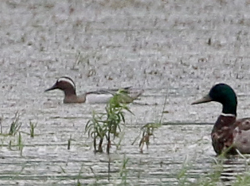 Garganey
Garganey
Montezuma NWR, Seneca, June 2016
Photo © Jay McGowan
(click photo to enlarge)
Garganey (Anas querquedula)
2016-21-A/D, One, Knox-Marcellus Marsh, Montezuma NWR, Town of Tyre, Seneca, 5, 8, 12 Jun, (Kimberly Sucy, Sean Sime, Richard Guthrie, Dominic Sherony; ph K. Sucy, Douglas Happ); eBird records 5-8, 10-12 Jun
On the morning of June 5, 2016, Jay McGowan and Livia Santana were birding along the locally well-known and heavily rutted dirt Towpath Road at Montezuma NWR, when they found an adult male Garganey. McGowan sent out text and email alerts immediately, allowing dozens of birders the opportunity to see this bird that day, as well as for more than a week afterward. Most of the sightings on subsequent days were from the west side of the same impoundment, where the duck was much more distant. Adult males are quite distinctive, and the identification was never in question. As with many species of waterfowl, initial reports for states and provinces have been questioned due to unknown provenance and the possibility of escape from waterfowl collections. However, Garganey has shown a pattern of vagrancy since the first North American record in 1957 from North Carolina (Howell et al. 2014). North American records increased rapidly from the 1970’s through the 1990’s but have declined markedly in western North America since, though they seem to be occurring at about the same rate in eastern North America in recent years (Howell et al. 2014). Despite an established pattern of vagrancy, observers should still look for possible signs of captivity when reporting this species, as with any vagrant waterfowl. The main indication of this possibility for a Garganey would likely be a colored band on one of the legs. Given the distances involved with viewing this bird and that it was usually in water or partially obscured by vegetation, seeing a band would have been difficult. Nobody reported seeing a band, either in reports submitted to NYSARC or in eBird reports, and given the established vagrancy pattern for the species, the Committee was comfortable accepting this first record for New York. A quick check of eBird reveals records from several nearby states and provinces, including Ohio, Ontario, Quebec, Vermont, Massachusetts, and New Jersey.
Garganey breeds across the mid latitudes of Europe to eastern Russia and winters south of the Sahara Desert in Africa, India, and southeast Asia (Howell et al. 2014; Beaman and Madge 1998). The main theory for how a vagrant might reach eastern North America involves fall migrants heading south or southwest toward Africa, drifting out over the Atlantic and being pushed by easterly trade winds until they make landfall in the Caribbean or northern South America. In the spring they would head north with their congeners, such as Blue-winged Teal (A. discors), and reach North America. This would also help to explain why records almost always involve single birds – since this species pairs up on the wintering grounds, if wintering outside its normal range, it is unlikely to encounter a prospective mate to migrate north with in the spring. Away from Alaska, virtually all North American records involve males during March – June (Howell et al. 2014). This may have to do with birder awareness plus the much more difficult identification challenge that females pose. The early June sighting of the bird at Montezuma fits into the pattern of spring discovery, though the date is later than almost all other occurrences south of Canada.
This is not the first report of Garganey that NYSARC has reviewed. On April 16, 1993, the late Bill Watson discovered a male at Tonawanda WMA in Genesee County. The bird was reported through April 19. The record (1993-19-A/D) was accepted for the identification but the origin was considered uncertain (Andrle et al. 1995). In the Region 1 report in The Kingbird, it states that “apparently this bird (and a Whooper Swan seen nearby) escaped from an area collector during the March blizzard” (Rising 1993). However, Andrle et al. (1995) reject this, stating “A rumor that a drake Garganey had been lost from a nearby private collection shortly before this observation was made is untrue (fide Ned Brinkley)”. Nevertheless, at a time when the vagrancy pattern of Garganey was not as well known, NYSARC chose to place the record in the Origins Uncertain category.
2015 REPORTS ACCEPTED
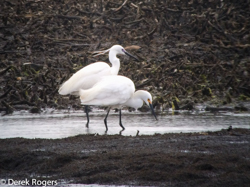 Little Egret
Little Egret
Gardiner County Park, Suffolk
May 2015
Photo © Derek Rogers
(click photo to enlarge)
Little Egret (Egretta garzetta)
2015-22-A/C One, Gardiner County Park and Thorne Preserve, Suffolk, 20, 21 May 2015 (Derek H. Rogers, Pete Morris, Michael S. Scheibel; ph D. Rogers, P. Morris, M. Scheibel)
While at Gardiner County Park near Bay Shore, Long Island, Pete Morris was recording Saltmarsh Sparrows (Ammodramus caudacutus) when he noticed a white egret that he assumed would be a Snowy Egret (E. thula). However, looking more closely, he noticed that the lores seemed dark, a feature that he knew to be consistent with Little Egret and not Snowy Egret. Having only brought binoculars and not being able to approach the bird any closer, he phoned Ken Feustel, who he convinced to come over and bring a spotting scope. Before Ken arrived, the bird flew up into a tree, and Morris was sure that he had seen two long head plumes catch in the wind as it landed, another strong feature suggesting Little Egret in breeding plumage. When Feustel arrived, the bird was more distant but the two found it in the scope and agreed that it looked really good, before the bird disappeared toward the adjacent Thorne Preserve. Although the Thorne Preserve was inaccessible to the general public due to a gated private community blocking the only access, Derek Rogers, as the preserve manager, was one of the few people who had access. Rogers arrived, picked up Morris and Feustel, and drove over to the preserve, where the three enjoyed much better views than were had at Gardiner Park and obtained excellent photographs, confirming the identification. Numerous birders were able to see the bird back at Gardiner Park the following day.
Identification of Little Egret in North America is mostly a matter of separation from Snowy Egret. The color of the loral skin differs and Little Egret has just two head plumes, as already mentioned, which are the two key features. However, there are also slight structural differences, which can be seen when one has a good comparison to a nearby Snowy Egret, as these observers did. The possibility of a hybrid Snowy X Little Egret should also be considered, as at least one such apparent individual has been recorded in the Northeast (Perkins 1995). The reports submitted by Morris and Rogers, in particular, were commendably thorough and included a discussion of how Snowy Egret and a hybrid could be ruled out.
Little Egret breeds and winters in southern Europe and Africa, as well as southern Asia and Japan south to Australia. Since the mid 1990’s it has bred in the southeastern Caribbean. There are about 30-40 records up to 2014 from the mid-Atlantic states northward to Newfoundland, with most of those along the coast (Howell et al. 2014, eBird). Most records in the Northeast are in mid-April to July and April to September on the mid-Atlantic coast (Howell et al. 2014). The mechanism for vagrancy to North America could involve spring overshoots, as the timing of birds arriving in spring in Iceland and Newfoundland is similar. Equally plausible is that birds from Europe overshoot their wintering areas in Africa and ride the trade winds to northeastern South America and nearby islands, such as Trinidad and Barbados. Then in spring, they would migrate north and reach North America, perhaps in the company of returning Snowy Egrets, Little Blue (E. caerulea), or Tricolored (E. tricolor) Herons (Howell et al. 2014). With the species now breeding in the Caribbean, records in North America could continue to increase. New York’s first record involved a bird along the coast in May and thus fits perfectly within the established pattern of vagrancy for this species. Little Egret has long been considered overdue to occur in the state. In “Predictions of species to be added to the New York State checklist – v. 4.0”, Little Egret was the runaway top vote-getter (Gochfeld 2010).
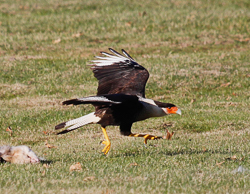
Crested Caracara
Montgomery, Orange
April 2015
Photo © Matthew Zeitler
(click photo to enlarge)
Crested Caracara (Caracara cheriway)
2015-4-A/B One, Doodletown, Bear Mountain State Park, Rockland, 5 Jan 2015 (Edwin McGowan, Gerhard Patsch); 2015-12-A One, Montgomery, Orange, 10, 12 Apr 2015 (Kenneth McDermott; ph K. McDermott); 2015-66-A One, Seaford, Nassau, 10 Jan 2015 (Steve Schellenger; ph Charles Sammut)
Prior to 1994 there were no records of Crested Caracara in the East north of Florida. Prior to 2003, there were only three records. Now, there are over three dozen (eBird), though there is likely to be some duplication with such a conspicuous species. Even those who delve deeply into the topic had no idea that this was about to happen. That is, not a single prognosticator chose it in the 2010 predictions of next species to be added to the New York checklist (Gochfeld 2010). With such a surge of new records in the last ten years, it is easy to see now why we have added Crested Caracara to the list of New York avifauna. For good measure, we actually added three records of this species in 2015. Only the Orange County record was unanimously accepted by the Committee. This is, perhaps, easy to understand as that bird, discovered by Curt McDermott and viewed by scores of birders over its one-week stay, was very well documented with photographs. The other two earlier sightings were each accepted by a vote of 6-1. The bird at Doodletown was viewed by experienced hawk-watchers as it soared overhead. Edwin McGowan, Gerhard Patsch, and David Baker knew very quickly that this was an unusual bird and were even suspecting that it was this species before they lost sight of it after about 30-40 seconds. Immediately after watching it, they confirmed their tentative identification by checking their field guides. The record at Seaford, on Long Island, was submitted by Steve Schellenger, on behalf of his acquaintance, Charles Sammut. Sammut noticed the bird on his neighbor’s fence and snapped a couple of photographs, which he forwarded to Schellenger. The bird was in a heavily suburbanized area, where the possibility that it was an escape would be considered greater than had it been found in a more rural area. However, with the explosion of records of this species in recent years, in addition to the two New York records mentioned above, the Committee was comfortable accepting this one as well. There exists the possibility that only one or two birds were involved in the three New York records, given the relatively close proximity in dates and locations. The Orange County bird was missing its left eye, which would make for a distinctive marker. Obviously, however, this could not be seen on the Doodletown bird, which was flying overhead, and the photos of the Long Island bird do not show the left side of the head. So, without specific evidence that only one or two birds were involved, the Committee decided to treat all three records separately.
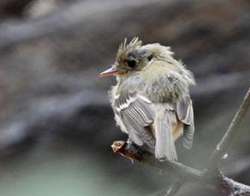 Pacific-slope Flycatcher
Pacific-slope Flycatcher
Central Park, New York
November 2015
Photo © Richard Guthrie
(click photo to enlarge)
Pacific-slope Flycatcher (Empidonax difficilis)
2015-56-A/D One, Central Park, Manhattan, New York, New York, 18, 21, 22 Nov 2015 (Peter Paul, Jack Rothman, Ardith Bondi, Richard Guthrie; audio P. Paul, video Tim Healy, ph Robert Rovulo, A. Bondi, R. Guthrie); eBird records 21-23 Nov
Discovered in venerable Central Park on Nov 18 by Robert Rovulo, who alerted nearby birders Jack Rothman and Brendan Keogh, this yellowish, crested, and obviously molting Empidonax flycatcher was initially identified as a Yellow-bellied (E. flaviventris), the only regularly occurring Empidonax in the East that is so strongly yellow below. After posting the sighting to the birding lists, it was suggested that one of the two “Western” Flycatchers was just as likely this late in the year, and Rovulo’s photos seemed to support that option. “Western” Flycatcher refers to the old name, before Pacific-slope and Cordilleran (E. occidentalis) Flycatchers were split into two species by the AOU, and it is still a useful moniker for this notoriously difficult-to-identify species pair. Unfortunately, the bird was not seen in subsequent days and for the most part forgotten, until Peter Paul relocated it on Nov 21. Over the course of the next three days the flycatcher was extensively photographed and, most importantly, its vocalizations were also recorded. While visual separation of “Western” Flycatcher from Yellow-bellied Flycatcher can be done with care, separating one of the “Western” Flycatchers from the other is not considered safe without hearing the call or, for some individuals, obtaining measurements in the hand. And since the two species are known to hybridize (Rush et al. 2009), even the call cannot be considered diagnostic to species, as a hybrid could conceivably give the call of either species. Like most of the stray “Western” Flycatchers before it, the Central Park bird appeared doomed to be left unidentified to species.
Like many other birders, Nathan Goldberg had ventured to Central Park to see the “Western” Flycatcher, but when he noticed the bird defecate on a leaf, he opportunistically collected the leaf with dropping. Goldberg and Nicholas Mason conducted an analysis of the mitochondrial DNA from the fecal sample obtained by Goldberg. They concluded that the haplotype representing the Central Park fecal sample was embedded within existing E. difficilis (Pacific-slope Flycatcher) haplotypes and was divergent from E. occidentalis (Cordilleran Flycatcher) (Goldberg and Mason 2017). Thus, their analysis supported the identification of the bird as a Pacific-slope Flycatcher, though a hybrid still could not be completely ruled out.
The photographs obtained, showing a ragged crest, tear-drop shaped eye-ring, brownish wings, and secondary edging that extended very close to the greater coverts (see Baumann et al. 2014 for a discussion of the latter field mark) were sufficient to rule out a Yellow-bellied Flycatcher. The recorded vocalizations were also not appropriate for Yellow-bellied. The overwhelming consensus of those who listened to the recordings was that they closely matched the slurred rising vocalization of a Pacific-slope Flycatcher and not the two-part call of a Cordilleran Flycatcher. In addition, the spectrogram was a match for Pacific-slope as well. Even though a hybrid cannot be ruled out with complete confidence, given the preponderance of evidence, the Committee voted to accept the Central Park bird as New York’s first Pacific-slope Flycatcher.
“Western” Flycatchers have been recorded about 14 times in the East from North Carolina northward (eBird). Six of those, including the Central Park bird, are believed to be Pacific-slope Flycatchers. There are no records of Cordilleran Flycatcher shown in eBird anywhere east of the Mississippi River in North America. Dates of occurrence for “Western” Flycatcher in the East range from mid Nov to mid Jan, with the great majority of records between mid Nov and mid Dec (eBird). The Committee wishes to acknowledge and thank Nathan Goldberg and Nicholas Mason for allowing us to review their paper prior to publication. In addition, Douglas Futuyma and Josh Dubnau were most generous in helping us to interpret this very technical paper. Shai Mitra also provided helpful comments.
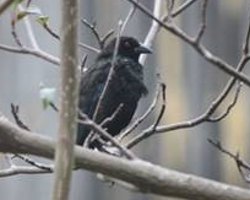 Bronzed Cowbird
Bronzed Cowbird
Norfolk, St. Lawrence
October 2015
Photo © Nora Lee
Bronzed Cowbird (Molothrus aeneus)
2015-51-A, Norfolk, St. Lawrence, 16-28 Oct (Nora Lee; ph N. Lee)
Although only a casual birder, Nora Lee still recognized that a blackbird that appeared in her yard in northern St. Lawrence County was different than the grackles and starlings that she normally sees. She was able to figure out that it was a Bronzed Cowbird, and she was also able to take some photographs. She even reported it to eBird, and the bird remained around her property for nearly two weeks! With eBird alerts, the situation was ripe for Ms. Lee to be receiving visits from numerous birders interested in adding the species to their state and life lists. And such would have been the happy outcome were it not for a minus sign. Apparently, Ms. Lee left it off of the longitude when she manually entered the GPS coordinates. As a result, the sighting appeared to be in Kazakhstan! By the time the mistake was noticed by eBird administrators and the sighting showed up in Jeff Bolsinger’s St. Lawrence County eBird review queue, it was too late, as the bird had apparently moved on, though Bolsinger made some effort to look for the bird himself.
Ms. Lee’s photographs show enough features that the Committee was fully confident that the identification was correct. The bird’s relatively short tail, heavy bill, red eyes, neck ruff, and blue in the wings can all be seen in her photos. Bronzed Cowbird was not a species on most people’s radar to make it to New York, although it was on one prognosticator’s list to appear in the state in each of the last two compilations (Gochfeld 2010, Gochfeld 2016). Bronzed Cowbird is a species of the southwest and the deep south in the U.S. There are only three other eBird records east of the Mississippi River: Nov 22, 2008 – Jan 4, 2009 in Charleston, South Carolina; Oct 24-28, 2010 in Rockland, Maine; and Apr 1-2, 2012 in Yarmouth, Nova Scotia. Unlike the New York record, all three of these were near the coast. In addition, all three are supported by clear photographs. However, Bronzed Cowbird is not included on the official South Carolina checklist as of the 2016 South Carolina Bird Records Committee annual report:
(https://www.carolinabirdclub.org/brc/checklist_of_South_Carolina_birds.html).
SPECIES ACCEPTED TO THE HYPOTHETICAL LIST
Carolina Parakeet (Conuropsis carolinensis)
1780-1-A Unspecified number, 25 miles northwest of Albany, Jan 1780 (B. S. Barton); 13, Buffalo, Erie, unspecified date (David F. Day); West Seneca, Erie, unspecified date and number (David F. Day); documentation for these reports submitted by Kathryn J. Schneider
The documentation for this unusual submission of an extinct species included a standard report with a summary of the pertinent details of where, when, how many, and by whom, as well as a thoroughly researched paper that has since been published in The Kingbird (Schneider 2015). As detailed in Schneider’s paper, the reports included a flock of parakeets seen 25 miles northwest of Albany in Jan 1780, a second-hand report of a flock of 13 in Buffalo on an unspecified date, and a second-hand report of unspecified numbers on unspecified dates in West Seneca (Erie County).
Included in Schneider’s paper is a range map, taken from Snyder and Russell (2002). This map shows the year-round range of the Carolina Parakeet extending across the southern half of the State, excluding Long Island. Snyder and Russell (2002) indicate that the rarity of records northeast of North Carolina suggests that this portion of the range was occupied only erratically. Although not explicitly stated, it seems reasonable to assume that this range map was based, in part, upon the same reports that Schneider details in her paper.
While reports lacking details that are likely known by the submitter are a frequent source of frustration for the Committee, this report was the opposite. The Committee was presented with what seemed to be virtually all of the known information regarding occurrences of Carolina Parakeet in the State and some of what is known from surrounding states. Unfortunately, without even a description of the birds that were reported and considering the second-hand nature of the reports, the Committee felt that the record was not fully supported. Nevertheless, the specimens and reports from neighboring states lent additional evidence that, together with that from New York, was strongly suggestive that New York State did host this species. As such, the Committee agreed that this species should be placed on the State’s Hypothetical List. While Carolina Parakeet was already placed on a hypothetical list by John Bull (1974), Bull’s Birds of New York State (Levine 1998) did not include a hypothetical list and, therefore, did not list this species at all.
Schneider (2015) argues that New Jersey and 11 other states include Carolina Parakeet on their state bird lists, even though they do not have a specimen record. She further states that “in nearly every case the documentation consists of similarly old informal sight records that are considered acceptable by historical standards.” While NYSARC has accepted sight records in the past and certainly will in the future, acceptable sight records would include a detailed description of the birds involved, as well as the circumstances of the observation, which are understandably lacking in the Carolina Parakeet accounts. The consensus of the Committee was that the historical accounts submitted for New York simply were not fully convincing. The Committee believes that it must maintain the same high standard for adding a bird to the State checklist that it has for every species.
Submitted on behalf of the New York StateAvian Records Committee:
Willie D’Anna (Chair), Gary Chapin (Secretary), Thomas W. Burke, Doug Gochfeld, Andrew Guthrie, Patricia J. Lindsay, James Pawlicki, and Derek H. Rogers
LITERATURE CITED
Andrle, R. F., K. P. Able, T. W. Burke, R. O. Paxton, and B. J. Spencer. 1995. Report of the New York State Avian Records Committee 1993. The Kingbird 45:71-78.
Beaman, M. and S. Madge. 1998. The Handbook of Bird Identification for Europe and the Western Palearctic. Princeton University Press, Princeton, N. J.
Baumann, M.J., S.C. Galen, N.D. Pederson, and C.C. Witt. 2014. Simple technique for distinguishing Yellow-bellied Flycatchers from Cordilleran and Pacific-slope Flycatchers. Journal of Field Ornithology 85: 391-396.
Bull, J. 1974. Birds of New York State. Doubleday / Natural History Press, Garden City, New York.
Gochfeld, D. 2010. Predictions of species to be added to the New York State checklist – v. 4.0. The Kingbird 60:301-310.
Gochfeld, D. 2016. What’s it gonna be? Predicting the next new additions to the avifauna of New York – a redux. The Kingbird 66:2-12.
Goldberg, N. R. and N. A. Mason. 2017. Species identification of vagrant Empidonax flycatchers in northeastern North America via non-invasive DNA sequencing. Northeastern Naturalist 24(4):499-504.
Howell, S. N. G., I. Lewington, and W. Russell. 2014. Rare Birds of North America. Princeton University Press, Princeton, N. J.
Levine, E. ed. 1998. Bull’s Birds of New York State. Cornell University Press. Ithaca, N. Y.
Perkins, S. 1995. New England Region. Field Notes 49:227.
Rising, G. R. 1993. Region 1 – Niagara Frontier. The Kingbird 43:211.
Rush, A. C., R. J. Cannings, and D. E. Irwin. 2009. Analysis of multilocus DNA reveals hybridization in a contact zone between Empidonax flycatchers. Journal of Avian Biology 40:614-624.
Schneider, K. J. 2015. The case for adding Carolina Parakeet (Conuropsis carolinensis) to the Checklist of the Birds of New York State. The Kingbird 65:170-175.
Snyder, N. F. and K. Russell. 2002. Carolina Parakeet (Conuropsis carolinensis), version 2.0. In The Birds of North America (P. G. Rodewald, editor). Cornell Lab of Ornithology, Ithaca, N.Y., USA. https://doi.org/10.2173/bna.667 |

